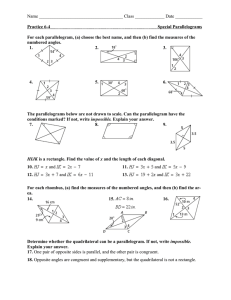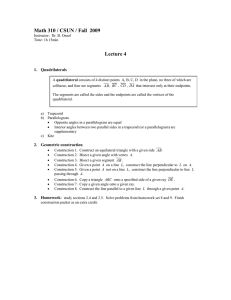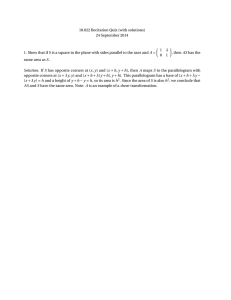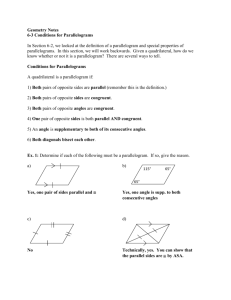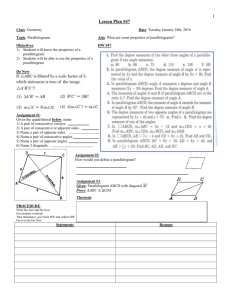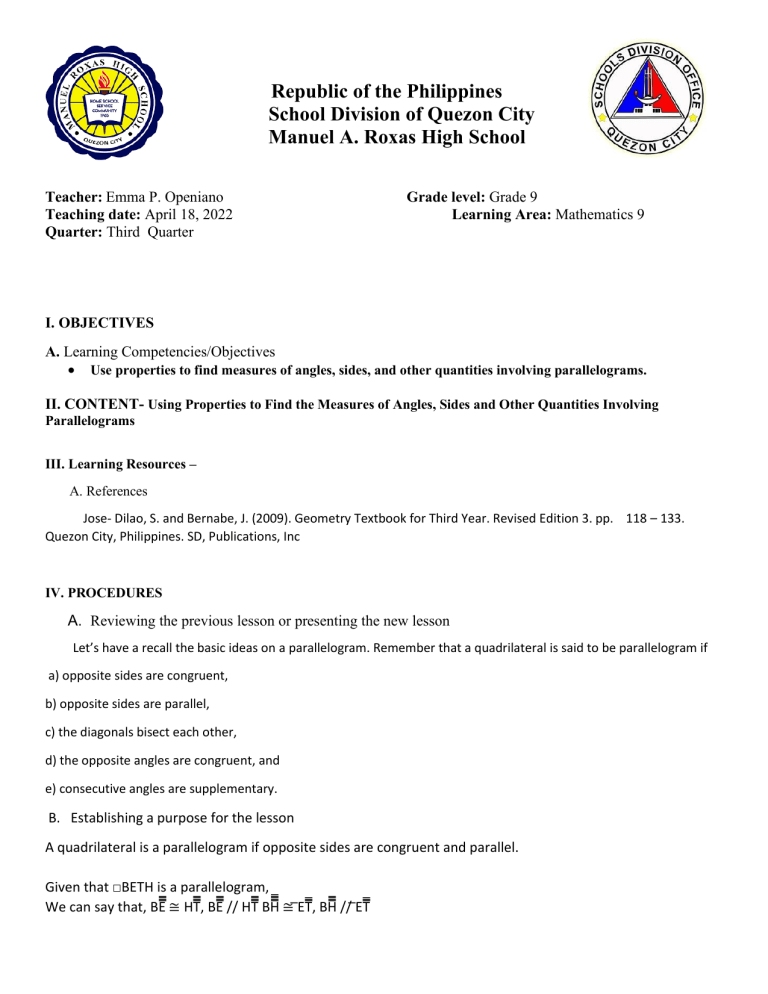
Republic of the Philippines School Division of Quezon City Manuel A. Roxas High School Teacher: Emma P. Openiano Teaching date: April 18, 2022 Quarter: Third Quarter Grade level: Grade 9 Learning Area: Mathematics 9 I. OBJECTIVES A. Learning Competencies/Objectives • Use properties to find measures of angles, sides, and other quantities involving parallelograms. II. CONTENT- Using Properties to Find the Measures of Angles, Sides and Other Quantities Involving Parallelograms III. Learning Resources – A. References Jose- Dilao, S. and Bernabe, J. (2009). Geometry Textbook for Third Year. Revised Edition 3. pp. 118 – 133. Quezon City, Philippines. SD, Publications, Inc IV. PROCEDURES A. Reviewing the previous lesson or presenting the new lesson Let’s have a recall the basic ideas on a parallelogram. Remember that a quadrilateral is said to be parallelogram if a) opposite sides are congruent, b) opposite sides are parallel, c) the diagonals bisect each other, d) the opposite angles are congruent, and e) consecutive angles are supplementary. B. Establishing a purpose for the lesson A quadrilateral is a parallelogram if opposite sides are congruent and parallel. Given that □BETH is a parallelogram, We can say that, BE̅̅̅̅̅̅̅̅̅̅̅̅ ≅ HT̅̅̅̅̅̅̅̅̅̅̅̅, BE̅̅̅̅̅̅̅̅̅̅̅̅ // HT̅̅̅̅̅̅̅̅̅̅̅̅ BH̅̅̅̅̅̅̅̅̅̅̅̅ ≅ ̅ET̅̅̅̅̅̅̅̅, BH̅̅̅̅̅̅̅̅̅̅̅̅ // ̅ET̅̅̅̅̅̅̅̅ B. Presenting examples/ instances of the lesson Example 1 □HELP is a parallelogram. If |𝐻𝐸| = 3x and |PL| = 12 cm, find the value of x Step 1. Draw the given. Step 2. Identify relationships. Identify the opposite sides HE̅̅̅ ≅ ̅̅̅PL̅̅̅ HP̅̅̅̅̅̅ ≅ EL̅̅̅̅̅̅ . Formulate the equation and solve. |HE| = |PL| 3x = 12 x=4 Step 4. Answer the question in the problem. The value of x is 4. D. Discussing new concepts and practicing new skills #2 The consecutive angles are: 1) ∠B and ∠E 2) ∠E and ∠T 3) ∠T and ∠H 4) ∠H and ∠B The opposite angles are 1) ∠B and ∠T 2) ∠H and ∠E Any pair of consecutive angles are supplementary. The sum of their measures is 180° Example 1 □JAKE is a parallelogram. If m∠J = 62°, find the measures of the other 3 angles. Solution: Step 1. Draw and mark the given. Step 2. Identify the relationship of each angle to angle J. ∠K is the opposite of ∠J therefore m∠K = m∠J = 620 ∠E is consecutive to ∠J m∠E + m∠J = 180° m∠E + 62° = 180° m∠E = 180° – 62° = 1180 ∠A is consecutive to ∠J m∠A + m∠J = 180° m∠A + 62° = 180° m∠A = 180° – 62° = 118 ° Example 2 □JAKE is a parallelogram. If m∠J = 62°, find the measures of the other 3 angles. Solution: Step 1. Draw and mark the given. Step 2. Identify the relationship of each angle to angle J. ∠K is the opposite of ∠J therefore m∠K = m∠J = 620 ∠E is consecutive to ∠J m∠E + m∠J = 180° m∠E + 62° = 180° m∠E = 180° – 62° = 1180 ∠A is consecutive to ∠J m∠A + m∠J = 180° m∠A + 62° = 180° m∠A = 180° – 62° = 118 ° Example 3 □STAR is a parallelogram. If m∠T = x, m∠R = 880, m∠AST = 320 and m∠RAS = 2y, find the values of x, y, z, and m∠TAS. Solution: a) ∠T and ∠R are opposite angles, therefore m∠T = x = m∠R x = 88° b) ∠R and ∠S are supplementary: m∠R + m∠S = 180, and m∠S = m∠RSA + m∠AST m∠R + m∠RSA + m∠AST = 180 88° + z + 32° = 180 z +120° =180 z =180 - 120° z = 60° c) ∠RAS and ∠AST are alternate interior angles, therefore they are congruent. m∠RAS = m∠AST 2y = 32° y =16° Example 4 The measures of angles L and I of parallelogram LINK are in the ratio of 2:7. Find the measure of each angle. Step 1. Draw the given. Step 2. Identify the relationship of the given. Since ∠L and ∠I are consecutive angles, then they are supplementary. mL + m∠I = 180° Let x be the common factor of each angle. m∠L = 2x m∠I = 7x Step 3. Formulate the equation and solve. So we have, m∠L + m∠I = 180° 2x + 7x = 180° 9x = 180° x = 20° E. Discussing new Concepts and practicing new skills #3 Suppose we have parallelogram ABCD, and the diagonals AC̅̅̅̅̅̅̅̅̅̅̅̅ and BD̅̅̅̅̅̅̅̅̅̅̅̅ intersect E then: • Diagonal AC̅̅̅̅̅̅̅̅̅̅̅̅ is cut into two congruent segments namely: AE̅̅̅̅̅̅̅̅̅̅̅̅ and at point CE̅̅̅̅.̅̅̅̅̅̅̅̅ Thus |AE| = ½|AC| and |CE| = ½|AC| • Diagonal BD̅̅̅̅̅̅̅̅̅̅̅̅ is cut into two congruent segments namely: DE̅̅̅̅̅̅̅̅̅̅̅̅ and EB̅̅̅̅̅̅̅̅̅̅̅̅ . Thus |DE| = ½|BD| and |BE| = ½ F. Presenting examples/ instances of the lesson Example 1 □BRIX is a parallelogram. Its diagonals bisect each other at point E. If |BE| = 65 dm, find |BI| and |EI|. Solution: Step 1. Draw and mark the given. Step 2. Identify the relationship between what is asked and the given. |BE| = ½ |BI| |BE| = |EI| Step 3. Formulate the equation and solve. |BE| = ½|BI| |BE| = |EI| 65 dm = ½|BI| 65 dm = |EI| 2(65 dm) = |BI| 130 dm = |BI| Step 4. Answer the question in the problem. So, |BI| is 130 dm, and |EI| is 65 dm Example 2 The figure below is a parallelogram. Find the value of x. Solution: Step 1. Identify the relationship of the given. • MA and MN are congruent. Step 2. Formulate an equation and solve. 2x +15 = 90 2x = 90 -15 2x = 75 x = 37.5 G. Discussing new Concepts and practicing new skills #4 • The area (A) of a parallelogram is given by the formula 𝐴 = 𝑏ℎ where b is the length of the base and h is the height. • The perimeter of a parallelogram is the sum of the lengths of its four sides. It is given by the formula 𝑃 = 2𝑎 + 2𝑏 where a and b are consecutive sides of the parallelogram H. Presenting examples/ instances of the lesson Example 1 Find the area of the parallelogram LEAN below. Given: Height (h) = 7 cm Base (b) = 15 cm Solution: Use the formulas Area = 𝑏 ∙ ℎ A = (15)(7) A = 105 sq units Example 2 □STAR is a parallelogram. Find its perimeter if |SR| and |ST| are 32 cm and 43 cm respectively. Solution: Use the formula for the perimeter. Perimeter = 2|𝑆𝑇| + 2|𝑆𝑅| P = 2(43) +2(32) = 86 + 64 P = 150 cm I. . Making generalizations and abstractions about the lesson A parallelogram is a quadrilateral in which both pairs of opposite sides are parallel. PROPERTIES OF A PARALLELOGRAM 1. Opposite sides are congruent and parallel. 2. Opposite angles are congruent. 3. Consecutive angles are supplementary. 4. Diagonals bisect each other • • • The total surface (or the region) occupied by a closed figure is called an area The perimeter, P, of a parallelogram is the sum of the lengths of its four sides. The area (A) of a parallelogram is given by the formula 𝐴 = 𝑏ℎ where b is the length of the base and h is the height. • The perimeter of a parallelogram is the sum of the lengths of its four sides. It is given by the formula 𝑃 = 2𝑎 + 2𝑏 where a and b are consecutive sides of the parallelogram. J. Evaluate Learning Direction: Write your answers on your answer sheet. I. Find the value of the variable that will make each quadrilateral a parallelogram. 1. x =______________ 2. x = ____________ y =______________ y = ____________ II. Solve the following. a. Find the perimeter of the parallelogram given the measures of its consecutive sides a and b. 1. a = 12 cm b = 4 cm 2. a = 23 m b = 11 m 3. a = 31 dm b = 15 dm B. Find the area of the parallelogram given its base and height. 1. b= 23 cm h = 21 cm 2. b= 13 dm h = 11 dm 3. b= 45 mm h = 25 mm V. REMARKS IV. REFLECTION 1. No.of learners who earned 80% on the formative assessment 2. No.of learners who require additional activities for remediation. 3. Did the remedial lessons work? No.of learners who have caught up with the lesson. 4. No.of learners who continue to require remediation 5. Which of my teaching strategies worked well? Why did these work? 6. What difficulties did I encounter which my principal or supervisor can help me solve?
